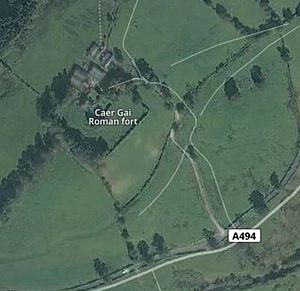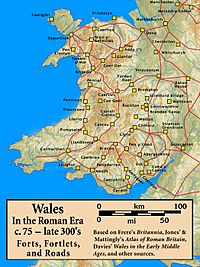Caer Gai facts for kids

Aerial view of Caer Gai
|
|

Location of Caer Gai within the Roman Province of Britannia
|
|
| Location | Penllyn, Gwynedd |
|---|---|
| Region | Wales |
| Coordinates | 52°52′6.312″N 3°40′10.74″W / 52.86842000°N 3.6696500°W |
| Altitude | 200 m (656 ft) |
| Type | fort |
| Area | 4 acres (1.6 ha) |
| History | |
| Builder | Roman Army |
| Material | First fort: earth and wood Second fort: stone |
| Founded | 1st - 2nd centuries CE |
| Abandoned | 5th century CE |
| Periods | Classical antiquity |
| Cultures | Roman Britain |
| Associated with | Auxilia (Nervii) |
| Site notes | |
| Condition | earthworks |
| Management | CADW |
| Designation | ME018 |
Caer Gai is an old Roman fort in Gwynedd, Wales, in the UK. It's a special historical site, listed as Grade II. You can find it about 1 mile (1.6 km) north of Llanuwchllyn village. It's also about the same distance west of Lake Bala.
What's in a Name?
We don't know the original Roman name for this fort. But during the Middle Ages, people started connecting the site to a famous legend.
The fort became linked to a hero named Cai. He was the son of Cynyr. Cai is a well-known character in the stories of King Arthur and his knights.
Old Welsh poems and stories mention Caer Gai as Cai's home. These include works by the Bards of the Nobility. Other medieval Welsh tales like Culhwch and Olwen also talk about the fort.
History of Caer Gai
Roman Times
The first fort at Caer Gai was built a long time ago. This was around the 1st century CE, when Emperor Titus was in charge. It was made from wood and earth.
The Romans chose this spot carefully. It was right next to the River Dee. There was a place to cross the river, called a ford. Two important Roman roads also met here.
One road was a smaller part of Sarn Helen. It connected Caer Gai to a big Roman city called Deva Victrix (now Chester). It also linked to a fort at Brithdir, Caerphilly. The other road went to another Roman outpost, Tomen y Mur.
The fort was built on a small hill. It had steep slopes on three sides, which helped protect it. Mountains like Arenig Fawr and the Berwyn Mountains surround the area.
Later, in the 2nd century CE, the Romans built a new fort. This one was much stronger, made of stone. It covered about 4 acres (1.6 hectares).
Archaeologists found a piece of a statue at the site. It had a Latin message carved into it. The message said that a soldier named Julius, son of Gavero, built it. He was part of the 1st Cohort of the Nervii, a group of Roman soldiers.
This statue was found in a special area. It was about 100 meters (328 feet) east of the fort. Old pottery pieces were also found there. These items showed the area was used around the early 2nd century AD.
After the Romans
Even after the Romans left, people continued to live at Caer Gai. The fort became home to a famous poet named Tudur Penllyn. He lived there from about 1420 to 1485. His son, Ieuan, also lived there.
Tudur got the fort when he married Gwerful Fychan. She was related to a powerful local leader named Rhirid the Wolf. It's possible Rhirid owned the fort even earlier, around the 1100s.
Historical records show that important meetings were held at the fort. These were like court sessions for the Penllyn area. Later, these meetings moved to the town of Bala.
In the 1600s, a poet named Rowland Vaughan built a large house on the fort's site. He was a supporter of the King during the English Civil War. His house burned down in 1645 during the war. But a farmhouse was built there later.
Visiting Caer Gai Today
Today, Caer Gai is looked after by CADW. This is the Welsh government's historic environment service. The site is open for everyone to visit.
You can still see parts of the fort's stone walls. In some places, you can see up to five layers of the original stonework.
Archaeologists have also found other interesting things nearby. About 400 meters (1,312 feet) north-east of the fort, they found a Roman tomb. They also found signs of another building to the south-east. This was probably a Roman bath house.
It's believed that a small civilian settlement, called a vicus, grew up around the fort. This was common for Roman forts, as people would live near the soldiers.

